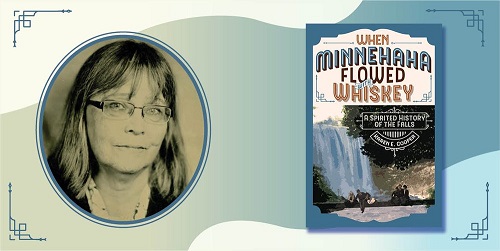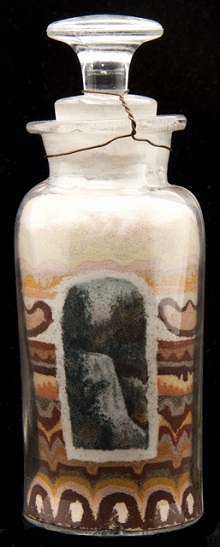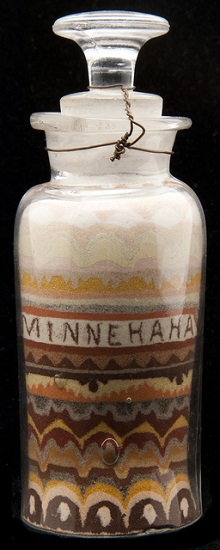New Local Book: “When Minnehaha Flowed with Whiskey: A Spirited History of the Falls”
 Saturday, October 8, 2022 at 1:20PM |
Saturday, October 8, 2022 at 1:20PM |  Michael Rainville Jr |
Michael Rainville Jr | Article by Michael Rainville, Jr.
 Above, Karen E. Cooper and the book cover of When Minnehaha Flowed with Whiskey: A Spirited History of the Falls. Graphic courtesy of Ice House MPLS
Above, Karen E. Cooper and the book cover of When Minnehaha Flowed with Whiskey: A Spirited History of the Falls. Graphic courtesy of Ice House MPLS
 Front view of one of Robert E. Fischer's sand art works depicting Minnehaha Falls, courtesy of MNHSIn August of 2022, the Minnesota Historical Society Press published a book by Karen E. Cooper about the lively history of Minnehaha Falls, one of Minneapolis’ treasures. Cooper, once a resident of Minnehaha Parkway, is an avid collector of all things Minnehaha, including over 1,000 images of the falls and its surroundings. She has dedicated a great amount of time researching, studying, and giving tours about the history of the falls, its landscape, and the many people who have lived around and visited Minnehaha. This is evident in her new book. She leaves no stone unturned as she travels through time from the early 1800s when Fort Snelling was established through the beginning of the next century when the Minnehaha Park we all know and love was starting to take shape.
Front view of one of Robert E. Fischer's sand art works depicting Minnehaha Falls, courtesy of MNHSIn August of 2022, the Minnesota Historical Society Press published a book by Karen E. Cooper about the lively history of Minnehaha Falls, one of Minneapolis’ treasures. Cooper, once a resident of Minnehaha Parkway, is an avid collector of all things Minnehaha, including over 1,000 images of the falls and its surroundings. She has dedicated a great amount of time researching, studying, and giving tours about the history of the falls, its landscape, and the many people who have lived around and visited Minnehaha. This is evident in her new book. She leaves no stone unturned as she travels through time from the early 1800s when Fort Snelling was established through the beginning of the next century when the Minnehaha Park we all know and love was starting to take shape.
When Minnehaha Flowed with Whiskey is full of raucous, liquored-up stories that Cooper brings together to give readers a sense of what living in Minneapolis in the 19th century was like, the good and the bad. One of the stories I found particularly interesting is about sand art. While there are still many sand artist throughout the country today, that art form was very popular in the 19th century. One of the more popular sand artists was Andrew Clemens, who was born in Iowa and made breathtaking art that was coveted by many. In 1889, a dime museum in Saint Paul hosted a show featuring the work of Clemens, who also was on hand to showcase his work.
 Back view of the same art piece, courtesy of MNHSMinnehaha Falls attracted many entrepreneurs and people who were trying to make a quick buck. Stands selling many types of souvenirs to the tourists at the falls were a common site in the later half of the 19th century, and one man decided to try his hand at making and selling sand art, perhaps inspired by the popularity of Andrew Clemens. That man was Robert E. Fischer, a onetime park policeman, park board member, and sand artist. Fischer learned the craft of sand art from a man by the name of Luther Melvin Hyde, also known as L. Mel. He would have attended the dime museum to witness Andrew Clemens create his art according to author Karen E. Cooper, and L. Mel in turn passed down his knowledge to Fischer.
Back view of the same art piece, courtesy of MNHSMinnehaha Falls attracted many entrepreneurs and people who were trying to make a quick buck. Stands selling many types of souvenirs to the tourists at the falls were a common site in the later half of the 19th century, and one man decided to try his hand at making and selling sand art, perhaps inspired by the popularity of Andrew Clemens. That man was Robert E. Fischer, a onetime park policeman, park board member, and sand artist. Fischer learned the craft of sand art from a man by the name of Luther Melvin Hyde, also known as L. Mel. He would have attended the dime museum to witness Andrew Clemens create his art according to author Karen E. Cooper, and L. Mel in turn passed down his knowledge to Fischer.
Fischer claims to have created over 45,000 pieces in his day, including those of Minnehaha Falls that he sold as souvenirs. He eventually moved out west to create sand art of picturesque scenes around Yellowstone and Glacier National Parks, using sand found in those locations. If sealed properly, sand art can last for a very long time. However, it can be difficult to track down those works of art that have stayed in a good condition. Fortunately, local institutions have acquired some of his work, such as the Minnesota Historical Society and the Hennepin History Museum, which put on an exhibition on Fischer’s work from March 20th, 2019 to May 31st, 2019 titled “Robert Emil Fischer: The Sand Man of Minnehaha Falls.”
The story of Robert E. Fischer and many others can be found throughout this fascinating, new book, When Minnehaha Flowed with Whiskey: A Spirited History of the Falls. Karen E. Cooper has done an outstanding job at compiling the remarkable history of Minnehaha Falls and its surroundings. Saying this book is a page-turner is an understatement. If you’re a local history buff, want a glimpse into Minneapolis past, or love taking strolls along Minnehaha Creek, this book is a must-have.
- - - - - - - - - - - - - - - - - - - - - - - - - -
 About Michael Rainville, Jr.
About Michael Rainville, Jr.
A 6th generation Minneapolitan, Michael Rainville Jr. received his B.A. in History from the University of St. Thomas, and is currently enrolled in their M.A. in Art History and Certificate in Museum Studies programs. Michael is also a historic interpreter and guide at Historic Fort Snelling at Bdote and a lead guide at Mobile Entertainment LLC, giving Segway tours of the Minneapolis riverfront for 7+ years. Contact: mrainvillejr@comcast.net. Click here for an interactive map of Michael's past articles.
